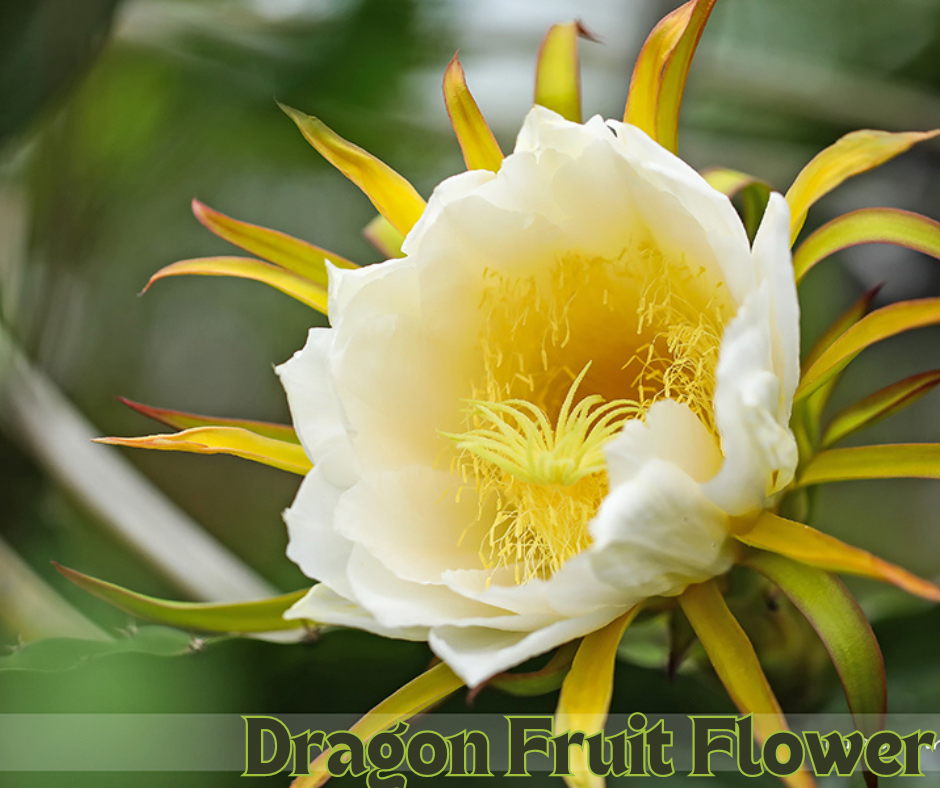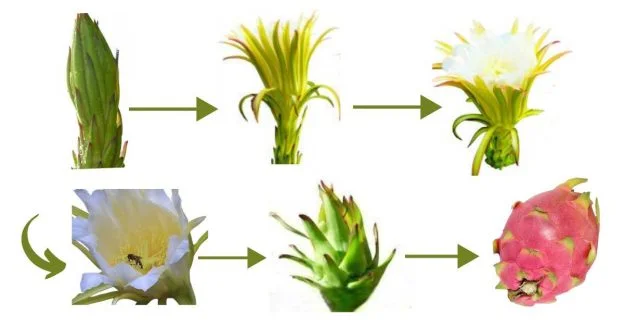Dragon fruit, also known as pitaya or pitahaya, is a tropical fruit that comes from the cactus species Hylocereus and Selenicereus. The dragon fruit flower is a large, showy flower that blooms overnight and typically lasts only one night. Here are some key features of the dragon fruit flower:

- Appearance: Dragon fruit flowers are usually large and ornate, with a diameter of around 25 cm (10 inches) or more. They have a unique appearance with elongated petals that can be white, yellow, pink, or red, depending on the species and variety.
- Fragrance: Dragon fruit flowers are known for their sweet and pleasant fragrance. The scent is often more pronounced during night to attract pollinators like moths and bats.
- Cultural Significance: In addition to being a popular fruit, the dragon fruit flower holds cultural significance in some regions where it is grown. The plant is associated with good luck and prosperity in certain cultures.
Dragon fruit flower stages

The development of a dragon fruit flower goes through several stages before transforming into the fruit. Here are the typical stages of a dragon fruit flower:
- Bud Formation: The process begins with the formation of flower buds. These buds appear at the end of the stem and gradually develop into mature flowers.
- Blossoming: Dragon fruit flowers typically blossom at night. The blooming process is rapid, and the flower opens up to reveal its intricate structure. The petals unfurl, exposing the reproductive organs of the flower.
- Night-flying animals like bats and moths are primarily responsible for pollinating dragon fruit flowers. The flowers are designed to attract these pollinators with their fragrance and sometimes by producing nectar. Successful pollination is essential for fruit development.
- Fertilization: After pollination, the male and female reproductive parts of the flower work together for fertilization. The pollen from the male parts (anthers) must reach the female part (stigma) to initiate the formation of seeds.
- Withering: Once the flower has been pollinated and fertilized, it begins to wither. The petals start to close, and the overall structure of the flower changes. This process usually occurs in the morning.
- Fruit Development: After successful fertilization, the flower transforms into a fruit. The ovary of the flower swells and develops into the dragon fruit. The fruit continues to grow, and its outer skin becomes the familiar scaly texture.
- Maturation: The dragon fruit matures over several weeks. The skin color may change, and the fruit becomes ready for harvest. The time it takes for a dragon fruit to mature can vary depending on the specific variety and growing conditions.
Understanding these stages is essential for dragon fruit cultivation, as it helps farmers optimize conditions for pollination and fruit development, ensuring a successful harvest.
Dragon fruit flower bud stages

A dragon fruit flower bud goes through several stages of development, each of which results in noticeable changes to the bud’s appearance. Here are the typical stages of a dragon fruit flower bud:
- Initiation: The process begins with the initiation of flower buds on the tips of the stem segments. These buds are usually small and tightly closed, resembling a small bump or node.
- Growth: As the bud continues to develop, it grows in size. During this stage, the bud becomes more noticeable, and its shape becomes more defined. The bud is still closed, protecting the developing flower inside.
- Differentiation: As the bud matures, it undergoes differentiation, where the various floral parts start to take shape. The sepals, petals, stamens, and pistils begin to form within the bud. The differentiation process sets the stage for the eventual blossoming of the flower.
- Swelling: Before blooming, the dragon fruit bud undergoes a phase of swelling. This is a crucial stage where the bud accumulates nutrients and water, preparing for the rapid expansion of the flower when it finally opens.
- Color Changes: In some dragon fruit varieties, the bud may undergo color changes as it approaches the blooming stage. Buds can exhibit shades of pink, red, or other colors, depending on the specific variety.
- Blossoming: The final stage is the blooming of the dragon fruit flower. The bud opens up to reveal the intricate structure of the flower, with its elongated petals and reproductive organs. Dragon fruit flowers typically bloom at night, and the blossoming process is relatively rapid.
Understanding the different stages of dragon fruit flower bud development is crucial for farmers and growers. It helps them anticipate when the flowers will bloom, facilitate proper care, and ensure optimal conditions for successful pollination and fruit set. Dragon fruit plants often produce multiple buds at different stages of development simultaneously, providing a continuous supply of flowers and fruit throughout the growing season.
Dragon fruit flower name
Common names for the dragon fruit flower include “pitaya flower” and “dragon fruit flower.” A variety of cactus species produce dragon fruit blossoms, which typically appear overnight. The blossom is big, frequently yellowish-white in color, and has a pleasant scent. The caterpillars and other creatures that sleep like bats fertilize it during its one-night bloom.
- White-fleshed Dragon Fruit:
- Flower Color: White or cream
- Red-fleshed Dragon Fruit:
- Flower Color: Red or pink
- Yellow Dragon Fruit:
- Flower Color: Yellow
- Purple Dragon Fruit:
- Flower Color: Purple

Dragon fruit flower Benefits
Some traditional medical practices and anecdotal evidence say that dragon fruit flowers may be good for your health in the following ways:
- Herbal Infusions and Teas: Dragon fruit blossoms have been utilized in various traditional medical procedures. There is some belief that these preparations may provide potential health benefits; however, the scientific evidence to support these assertions is quite limited.
- Rich in antioxidants: The blooms of dragon fruit are antioxidant-rich, just like the fruit itself. Antioxidants are known to eliminate free radicals, which may help reduce oxidative stress and inflammation in the body.
- Anti-inflammatory Properties: Several plants, notably several cacti that bear dragon fruit, are well renowned for their ability to reduce pain. Compounds in dragon fruit blossoms might be part of their anti-inflammatory properties.
- Phytochemicals: The blooms of dragon fruit, like other plant components, are full of different phytochemicals. There is a need for additional research to comprehensively clarify the potential health-promoting effects of these compounds.
It’s crucial to remember that, despite the possibility of certain health benefits, there hasn’t been much research done, particularly on the impact of eating dragon fruit blooms on one’s health. The majority of the health advantages linked to dragon fruit are attributed to the fruit itself.
What is special about dragon fruit flowers?
Dragon fruit flowers are notable for their eye-catching nighttime blooms, which are enormous and aromatic and play an important role in pollinator attraction. This plant’s reproduction depends on these flowers, which appear before the dragon fruit does. They are simply beautiful.
How long does a dragon fruit flower last?
Dragon fruit flowers only bloom for one night, from evening to morning. This short-lived blooming time is very important for getting pollinators to come out at night and start the fruiting process.
Why is my dragon fruit flower dying?
Dragon fruit flowers usually only bloom for one night, so they may die from natural senescence or because of things in their surroundings like not enough pollination, pests, or stress. To support floral health, make sure that flowers are properly pollinated, offer ideal growing circumstances, and take care of any problems like pests.
Table of Contents
To learn more about dragon fruit specialties, click here.
